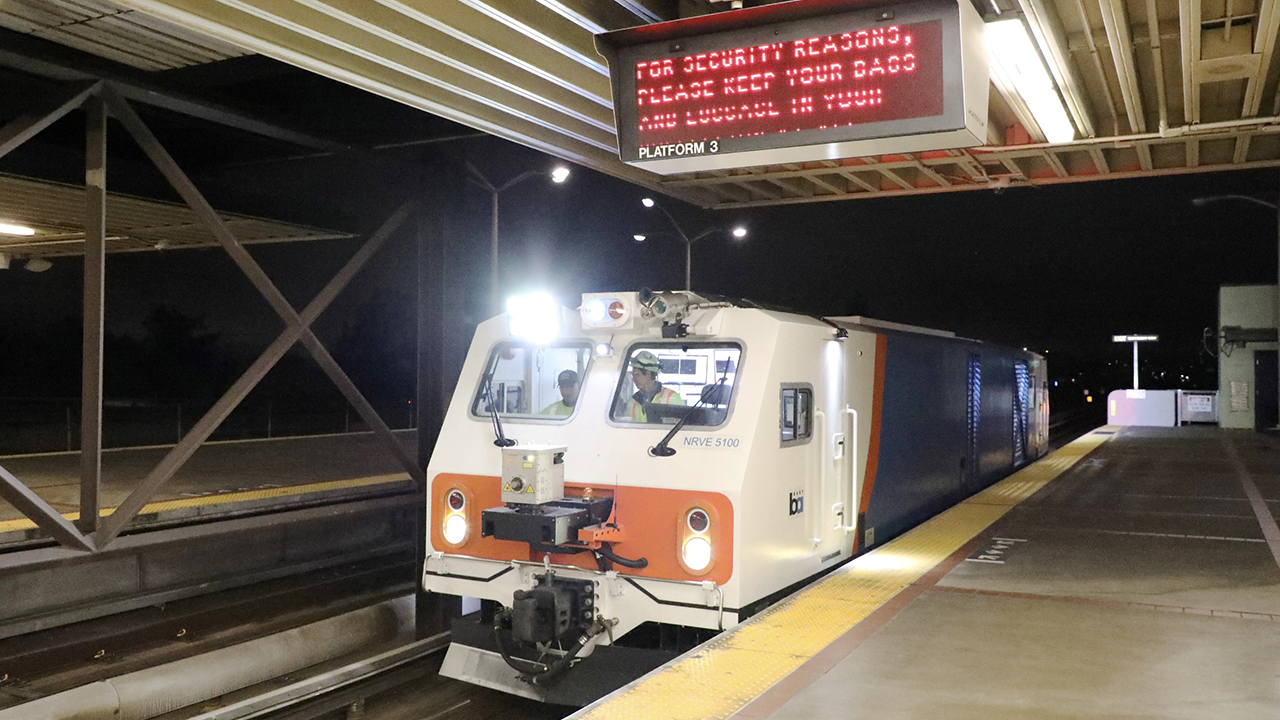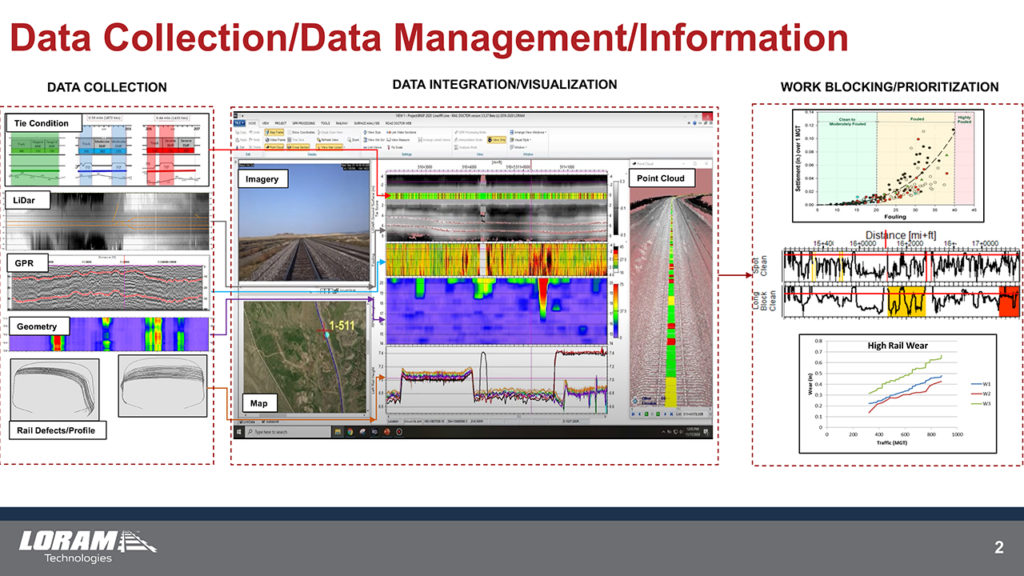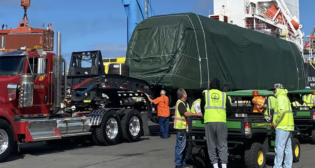
Rolling Laboratories
Written by Marybeth Luczak, Executive Editor
BART’s MERMEC-built rail inspection vehicle uses lasers, sensors and cameras as well as measuring and data management systems to create a comprehensive track profile, all while traveling at speeds of up to 70 mph.
RAILWAY AGE, JUNE 2023 ISSUE: Measuring and monitoring track geometry and detecting flaws beneath the track surface not only allows railroads to take action before failures occur, but also helps them to manage maintenance proactively, prolonging asset life.
The following suppliers provide updates on their latest equipment and services to assess and manage track health, plus their insights on where the market is headed.
MERMEC Inc., an Angel Company
San Francisco Bay Area Rapid Transit (BART) District last month unveiled its newly acquired rail inspection vehicle from MERMEC that measures track position, curvature, smoothness and alignment, plus wear and corrugation, which contribute to train noise. The $10 million, diesel-powered “rolling laboratory” is part of MERMEC’s ROGER series and was developed over the past nine years under Build America Buy America Act requirements, according to Scott McLaughlin, Vice President of Business Development-West for MERMEC. It uses lasers, sensors and cameras as well as measuring and data management systems to create a comprehensive track profile, all while traveling at speeds of up to 70 mph. Among its capabilities, the vehicle can create three-dimensional surface scans of the area around the track and capture hi-definition images that detect abnormalities in components such as concrete ties and fasteners. It can also capture video in both normal and low-light conditions, including in tunnels, and infrared thermal imagery. GPS, axle counters and radio-frequency identification tags pinpoint problem-area locations.
According to McLaughlin, MERMEC also recently released Rail Studio, “a platform that incorporates both artificial intelligence and in-cloud-based storage, and is able to visualize, analyze and interact with data from multiple collection systems,” including those from different vendors.
What’s next? “We are constantly interacting with our customers, getting valuable feedback, and making adjustments and improvements so the next iteration of our equipment provides more information and is more robust,” McLaughlin reports.
Plasser American Corporation
“Automation remains a hot topic” in the track geometry space, Plasser tells Railway Age. “Customers want to be able to cover the same amount of track with fewer people.” Also important today: fleet management and data analysis. The company says it “continues to provide customers with new and improved platforms to bring track geometry and track maintenance together.” Data generated through Plasser machines are compatible, it points out, which saves track time by eliminating the need for pre-measurement. Additionally, partnerships with other railroad technology companies allows Plasser to integrate third-party data into its domains.
The future of track geometry will be a mix of manned and autonomous vehicles, Plasser tells Railway Age—both of which it will offer in the near future.
Plasser recently entered the ultrasonic rail flaw detection (URFD) market and reports supplying both hi-rail and rail-bound options for service or purchase. The company is providing (or mobilizing to provide) Class I’s, Class IIs and transit agencies with URFD services, which it says will continue to expand in 2024 and 2025 within North America.
While Plasser says that “there is a sizeable need” for URFD for both stop and verify and continuous testing, it does “see a move away from eddy current and stop/verify and go with higher speed systems such as phased array, and a switch to continuous testing to cover more track within tighter schedules.”
Now under development is Plasser’s phased array system, which has entered the final stages of testing. It was designed to inspect the rail and find defects in the presence of surface conditions such as horizontal split heads, deep rolling contract fatigue and squats. “This new technology will replace the eddy current systems to check the first few millimeters of the rail for defects,” PAC reports.
ENSCO Rail, Inc.
“The North American market has fully embraced the benefits of rail-bound autonomous track geometry systems,” Rail Division Manager Jackie Van Der Westhuizen reports. “Currently, the number of autonomous rail-bound track geometry vehicles far outnumbers manned vehicles.”
ENSCO Rail recently deployed its first autonomous rail-surface imaging systems for a Class I railroad, and additional autonomous joint bar imaging systems for existing customers. “These systems accompany autonomous track geometry measurement systems to assess rolling contact fatigue and rail damage [and] to monitor rail integrity and inspect,” Van Der Westhuizen tells Railway Age.
What’s new in research and development? The company has developed digital twin capabilities, “made possible by combining our automated VAMPIRE processing with autonomous track geometry,” Van Der Westhuizen says. “With this capability, we can predict potential derailment locations in advance and provide instructions on how to correct defective conditions to prevent accidents.” Additionally, the company is leveraging its Automated Maintenance Advisor to predict future track conditions, he says, “which results in actionable maintenance plans and asset management strategies.”
ENSCO Rail also provides ultrasonic rail flaw systems (URFS), and it anticipates “a persistent need for more frequent and faster testing,” according to Van Der Westhuizen. “We expect that advancements in sensors, data analysis and machine learning will facilitate more sophisticated and accurate inspection techniques. This progress will fuel the development of continuous testing and automated inspection, which can rapidly scan vast segments of railway tracks and detect potential flaws or defects, thereby minimizing derailments and service disruptions.” Also, there is a growing trend to integrate and augment URFS with other types of inspection technologies, such as visual inspection, thermal imaging and magnetic particle inspection, he reports. “By combining these different inspection techniques, rail maintenance teams can get a more comprehensive understanding of track condition and make more informed decisions about maintenance and repairs.”
Harsco Rail
Harsco Rail offers the Callisto track geometry measurement system, which can be mounted on a hi-rail vehicle or integrated into a Harsco tamper’s control system. The portable, hi-rail-mounted system is currently hard-wired to a keyboard and touchscreen monitor in the cab, but within a year, the company may eliminate most wires by implementing Bluetooth communications, according to Tom Leiby, Director of Measurement Products. Harsco Rail is also working to improve how operators input data and to provide scalable track-geometry graphs, he tells Railway Age.
A Class I railroad is currently outfitting its tamper fleet with Callisto Protamp, which allows for a high-speed, pre-work track recording without the need for buggy extensions, Leiby says. This increases productivity as well as safety.
On the R&D side, Harsco Rail is testing an autonomous vertical rail displacement measurement system that it anticipates will be commercially available in first-quarter 2024. Mounted on heavy-weighted freight cars or almost any type of rail-bound equipment, the system will detect “mud spots” or weak points in the railbed that are not always visible, according to Leiby. “By knowing where these spots are, you can watch them, and/or undercut or do other work to eliminate them and stop the stress on the rail,” he explains.
In addition to track geometry inspection services, the company will soon offer ultrasonic rail flaw detection services, Leiby reports.
Herzog
“Rail flaw detection is a critical aspect of ensuring the safety and dependability of transit and freight rail systems,” Herzog tells Railway Age. “By using powerful ultrasonic technology (UT) and comprehensive data collection and analysis, Herzog’s hi-rail testing vehicles are capable of servicing rail tracks in any environment.”
The company offers turnkey Continuous Testing (CT) services and says that its CT platforms “are designed to capture robust and highly accurate data within short work windows, enabling a thorough assessment of rail infrastructure conditions.” These platforms, Herzog adds, employ multiple inspection technologies on a single vehicle, allowing for customization. Among the key features of its CT equipment and data processing are:
- SmartProbe technology: “The detection instrumentation within the wheel probe significantly accelerates processing time,” according to Herzog. “With 14 transducers per rail, it provides a superior signal-to-noise ratio and comprehensive coverage using 24 UT channels.”
- Geometry system: This system evaluates track gauge, alignment, curvature, surface conditions, cross-level, super-elevation, warp and twist.
- Joint bar inspection: “High-definition line scan cameras integrate detailed images of both the gauge and field side of the rail joint bar into the UT software data stream,” Herzog says. “This integration enables the quick identification of missing bolts, broken fasteners or cracks in the fish plate.”
- Historical record: Each indication is tracked across survey runs and prioritized based on its anticipated severity, according to Herzog, which notes that analysts can reference previous inspection scans and photo imagery to monitor any growth or changes.
- Pattern recognition: “UT data is analyzed using machine learning algorithms that automatically identify and classify various types of anomalies or defects that may be present in the rail,” Herzog reports.
Holland LP
How railroads use track geometry data is changing, with a move from reactive to proactive, data-driven maintenance, according to Senior Director of Product Development Sabri Cakdi. Since tracks are inspected multiple times per year, railroads can overlay data and look for trends. “In the past, you would provide an inspection technology to a railroad and they would run it, operate it, get a report and that was it,” he says. “Now, they ask us to integrate our system’s output to a cloud-based system.”
Another trend, Cakdi says, is the use of portable track geometry systems in yards. “If you look at Federal Railroad Administration derailment rates, there has been a huge reduction in main line derailments, but yard derailments are still significant,” he reports.
Holland’s portable Track Inspector is a full geometry system that offers two individual rail sensors depending on configuration and use, and can be mounted, configured and calibrated by one person in less than an hour, according to the company. Cakdi points out that the Argus® track measurement technology no longer uses a conventional wheel-mounted encoder; this has been replaced with a noncontact speed and distance measurement device so there are no hardware reliability issues.
Holland also offers Locomotive UGMS, a locomotive-based autonomous track geometry and rail profile measurement system. “Taking advantage of existing train routes, Locomotive UGMS provides continuous testing along critical network corridors while eliminating the need for track time,” the company reports.
Kawasaki Track Technologies
The current and long-term outlook for autonomous track inspection systems remains promising, Program Manager Ryoji Negi tells Railway Age. KTT’s locomotive-mounted “high-reliability, low-maintenance and low-cost per mile” system provides the geometry data rail owners need to identify and more quickly respond to potential problem areas, he says. Over the past year, the company has added a web-based track condition viewer and updated the system to include more real-time data, as well as functionality to download geometry strip charts. Cloud storage options are also available.
KTT is currently testing an automated fastener inspection system. Mounted on a locomotive, processing is completed on board and exceptions sent to customers in near real time. “This system is taking high-speed imagery of rail, ties, fasteners, ballast, and other track components and providing the data for our machine learning algorithms,” Negi says. “Initial results have been very promising and KTT is targeting early 2024 to have production systems available for installation. Once various fastener and tie combinations are completed, KTT will be able to utilize the same technology to identify potential exceptions on ties, joint bars, ballast and other track components.”
Loram Technologies, Inc.

LTI can target substructure issues and their underlying origins by integrating historical track geometry data provided by railroad customers with information derived from its Ground Penetrating Radar (GPR) and LiDAR systems. These systems measure ballast fouling, moisture conditions and track formation, and provide information about right-of-way topography, drainage ditch location, and depth and cut/fill conditions, respectively. The company’s Rail Doctor software brings together and aligns all data for analysis and, ultimately, to help railroads with substructure maintenance management—a proactive approach.
“The geometry data is a very good tool to find out where the track is not performing correctly, where it’s deteriorating,” says Hamed F. Kashani, Manager of Railway Geotechnics. “We can then go and look for the root cause of the problem and recommend to the railroad how to fix it.” Once any problems are corrected, LTI can monitor the track to determine if the provided solution was the right one.
The company is actively working on research projects with two universities to determine the best machines to resolve specific problems, according to Kashani. For instance, if a certain amount of fouling in the center of the track is detected by GPR, is undercutting or shoulder ballast cleaning the best way to fix it? “We want to find the best and economical solution for the condition,” he says. The company is also taking steps toward finding correlations between substructure and superstructure (rail and crosstie) defects as well as automating data collection and increasing the speed of analysis.
RailWorks Maintenance of Way
“Automated track geometry inspections continue to be an important part of our Maintenance of Way Division and for RailWorks as a company,” says Jason Deaton, Vice President and General Manager. “Providing accurate, reliable track geometry services for Class I’s, short lines and transit agencies across North America gives our customers an opportunity to view and understand their railroads’ health in real time.”
According to Deaton, customers are not only implementing track geometry inspections more frequently, but also using data software to view and analyze data in more detail to better manage maintenance resources, personnel and budgets. “Having the ability to view multiple or overlapping inspections allows customers to pinpoint locations that require attention before they become a track defect or problem area,” he says.
RailWorks is currently exploring technologies that can be incorporated into its Track Geometry Service Platform.
Wabtec Corporation
Customers today want more testing done faster, says Dave Staton, Vice President, General Manager of KinetiX Rail Inspection Technologies at Wabtec. It’s about “how fast can you get in, how fast can you get out,” he says. “And they want predictive results. There’s a lot of things that go into being able to make that happen. And part of that becomes our ability to enhance our analytical capabilities in evaluating inspection data by adding and integrating artificial intelligence into our background software.”
On Jan. 1, Wabtec brought track inspection, including ultrasonic rail flaw detection, under its KinetiX umbrella, which already comprised wayside inspection, such as hotbox detectors and bearing acoustic monitors. “Part of our vision is to connect those disparate inspection technologies to derive insights,” reports Alan Fisher, Group Vice President, Logistics, Analytics and Digital Mine at Wabtec.



